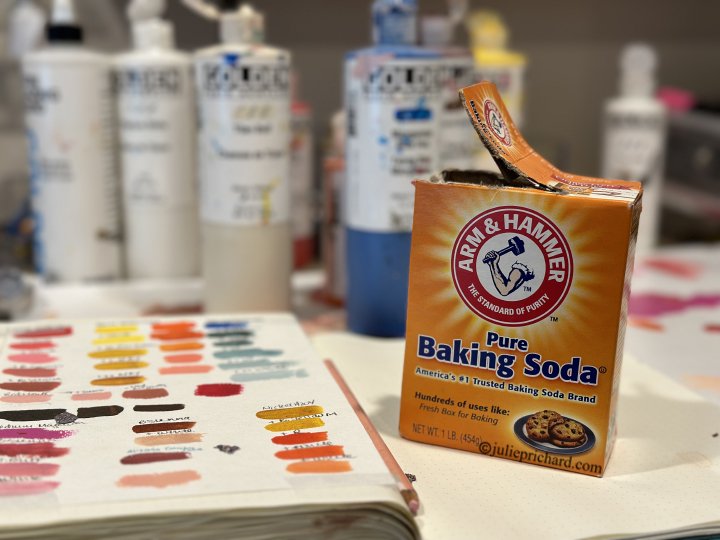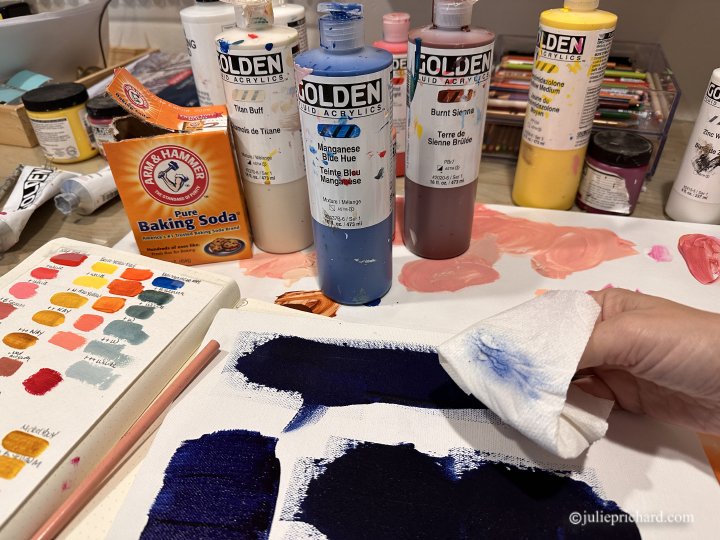Don't try everything you see on TikTok.. Baking Soda Edition.
I’ve been sidelined with some stitches in my back, so unfortunately for me, but fortunately for YOU, I’ve been spending a lot of time on my phone on the couch. A couple of weeks ago, a trend of mixing baking soda with paint blipped on to my radar, but I dismissed it.. yesterday I was stunned to see a gazillion people responding positively to this idea and working it into their abstract paintings.
Don’t mix baking soda into your abstract art.
Here are my findings:
Acrylic paint is made with complex recipes including a balance of pigment and binders. Read that again…a balance. Adding a load of baking soda to your art most certainly throws off that balance impacting the stability of the paint. What does this mean?
Stability refers to the longevity of the paint and it’s ability to withstand artist process. Once dry, acrylic paint should be able to withstand layering, mixing with additional acrylic mediums, and depending on the quality of your paint, a certain level of lightfastness, and archivability. Adding baking soda into the mixture, throws off the balance the paint manufacture has created.
I tested baking soda in acrylic paint and applied it two ways to a rigid canvas panel. In both tests, the baking soda plus acrylic paint dried with a matte finish and subtle granular texture. I also created the same mixture using Pastel Ground and Fiber Paste and applied it to the same panel. In my opinion, the dried acrylic with both Fiber Paste and Pastel Ground appeared more lively and rich, more sophisticated.
To the touch, each mixture felt similar, but I did notice that there seemed to be a reside on my fingertips when I rubbed over the baking soda mixture vs. the other two acrylic mixtures. The real danger presented itself when the baking soda got wet.
A few drops of water to simulate mixed media application or additional layering with acrylic paint proved the baking soda mixture had rendered itself unstable. A gentle wipe of a paper towel over the mixture left a dark blue paint residue on the towel. A subsequent test proved that the baking soda was indeed “eroding” off the panel. The water droplets did not impact the acrylic mediums I tested at all.
Additional testing showed that when using a lighter color paint over the baking soda mixture, the baking soda paint color bleed heavily into the non-baking soda paint and additional particles of baking soda came off of the canvas panel. This negates the possibility that varnish will be the solution to fickle baking soda paint mixtures, because the varnish will re-activate the baking soda paint. We did not text fixative, but experience tells me that fixative, while it proves strong enough to stabilize pencil, it will not have enough binder to prevent bleed and “flaking” when used under varnish. (Click here to watch my free varnish and fixative video tutorial.)
Baking soda is cheap and I can understand why it is an attractive alternative.. but your concern about budget should be the very reason why you leave baking soda in the kitchen cupboard. When mixing my sample, the baking soda proved to be VERY absorbent compared to my acrylic mediums, and a lot more paint was required to maintain the viscosity of the paint. (The paint was very difficult to spread when mixing with baking soda and the mixture required about 4 times the amount of paint that I used in the acrylic medium mixtures.)
For its stability, archivability and potential problems with flaking and cracking, baking soda gets a NO from me. Save it for cookies.
Click here to watch my instagram live video on this topic.
(Non-sponsored post. The artist has no affiliation with Golden Paint or Arm & Hammer. She does have a serious relationship with cookies.)

